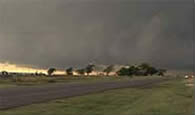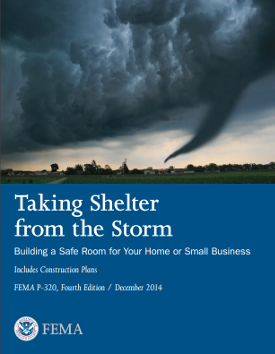Severe Weather
Local Weather via the National Weather Service
Thunderstorms that precede a cold front are generally stronger and more likely to reach severe proportions than localized thunderstorms associated with tropical air masses. A few things must happen in the earth's atmosphere in order for a thunderstorm to become severe. By definition, a severe thunderstorm is a thunderstorm that contains any one or more of the following three weather conditions:
- Hail that is 3/4 of an inch or greater in diameter
- Winds 58 miles per hour or greater
- Tornadoes

Supercell thunderstorms are fierce and can sometimes discharge a number of tornadoes. They are tremendously powerful and well-organized, containing rotating columns of rising air.
These storms are capable of maintaining severe thunderstorm strength for hours. They can also produce dangerous straight line winds, large hail and torrential rain. Sometimes these storms spawn particularly strong tornadoes.
Frequently, a severe thunderstorm develops as part of a cold front associated with strong jet stream winds in the upper levels of the troposphere. Spurred on by the jet stream, this line of severe thunderstorms is called a squall line. Bow echoes associated with squall lines or mesoscale convective systems can produce widespread damage.
Mitigation
Mitigation includes any activities that prevent an emergency, reduce the chance of an emergency happening, or lessen the damaging effects of unavoidable emergencies. Investing in preventive mitigation steps now, such as installing lightning rods to carry the electrical charge of lightning bolts safely to the ground or purchasing flood insurance, will help reduce the impact of severe thunderstorms in the future.
Downbursts And Microbursts
Severe thunderstorms can create incredible violence as they pass over an area. Among their most devastating aspects are downbursts.

A downburst is a severe localized wind blasting down from a thunderstorm. These strong downward currents are classified by meteorologists as microbursts if the downburst covers an area less than 2.5 miles in diameter and as macrobursts if the downburst covers an area of at least 2.5 miles in diameter.
Wind shear is any sudden change of speed or direction in wind flow. Since a microburst is a sudden vertical drop of air, it produces considerable wind shear.
Thunderstorms and Lightning
Some thunderstorms can be seen approaching, while others hit without warning. It is important to learn and recognize the danger signs and to plan ahead.
Before
Learn the Thunderstorm Danger Signs
- Dark, towering, or threatening clouds
- Distant lightning and thunder
Have Disaster Supplies on Hand
- Flashlight with extra batteries
- Portable, battery-operated radio and extra batteries
- First aid kit and manual
- Emergency food and water
- Nonelectric can opener
- Essential medicines
- Cash and credit cards
- Sturdy shoes
Check for Yard Hazards
Dead or rotting trees and branches can fall during a severe thunderstorm and cause injury and damage.
Educate Family Members
Make sure that all family members know how to respond after a thunderstorm. Teach family members how and when to turn off gas, electricity and water.
Educate Children
Teach children how and when to call 9-1-1, police, fire department, and which radio station to tune for emergency information.
Severe Thunderstorm Watches & Warnings
A severe thunderstorm watch is issued by the National Weather Service when the weather conditions are such that a severe thunderstorm (damaging winds 58 miles per hour or more, or hail three-fourths of an inch in diameter or greater) is likely to develop. This is the time to locate a safe place in the home and tell family members to watch the sky and listen to the radio or television for more information. A severe thunderstorm warning is issued when a severe thunderstorm has been sighted or indicated by weather radar. At this point, the danger is very serious and everyone should go to a safe place, turn on a battery-operated radio or television, and wait for the "all clear" by the authorities.
Tornadoes & Flash Floods
Learn how to respond to a tornado and flash flood. Tornadoes are spawned by thunderstorms and flash flooding can occur with thunderstorms. When a "severe thunderstorm warning" is issued, review what actions to take under a "tornado warning" or a "flash flood warning."
Develop a Plan
Develop an emergency communication plan. In case family members are separated from one another during a thunderstorm (a real possibility during the day when adults are at work and children are at school), have a plan for getting back together.
Emergency Contacts
Ask an out-of-state relative or friend to serve as the "family contact". After a disaster, it's often easier to call long distance. Make sure everyone knows the name, address, and phone number of the contact person.
Contact your local emergency management office or American Red Cross chapter for more information on thunderstorms and lightning.
During
Indoors
- Secure outdoor objects such as lawn furniture that could blow away or cause damage or injury. Take light objects inside.
- Shutter windows securely and brace outside doors.
- Listen to a battery operated radio or television for the latest storm information.
- Do not handle any electrical equipment or telephones because lightning could follow the wire. Television sets are particularly dangerous at this time.
- Avoid bathtubs, water faucets, and sinks because metal pipes can transmit electricity.
Outdoors
- Attempt to get into a building or car.
- If no structure is available, get to an open space an squat low to the ground as quickly as possible. (If in the woods, find an area protected by low clump of trees. Never stand underneath a single large tree in the open.) Be aware of the potential for flooding in low-lying areas.
- Crouch with hands on knees.
- Avoid tall structures such as towers, tall trees, fences, telephone lines, or power lines.
- Stay away from natural lightning rods such as golf clubs, tractors, fishing rods, bicycles, or camping equipment.
- Stay from rivers, lakes, or other bodies of water.
- If you are isolated in a level field or prairie and you feel your hair stand on end (which indicates that lightning is about to strike), bend forward, putting your hands on your knees. A position with feet together and crouching while removing all metal objects is recommended. Do not lie flat on the ground.
In a Car
- Pull safely onto the shoulder of the road away from any trees that could fall on the vehicle.
- Stay in the car and turn on the emergency flashers until the heavy rains subside.
- Avoid flooded roadways.
Estimating the Distance From a Thunderstorm
Because light travels much faster than sound, lightning flashes can be seen long before the resulting thunder is heard. Estimate the number of miles you are from a thunderstorm by counting the number of seconds between a flash of lightning and the next clap of thunder. Divide this number by five.
Important: You are in danger from lightning if you can hear thunder. Knowing how far away a storm is does not mean that you're in danger only when the storm is overhead.
Hail
Hail is produced by many strong thunderstorms. Hail can be smaller than a pea or as large as a softball and can be very destructive to plants and crops. In a hailstorm, take cover immediately. Pets and livestock are particularly vulnerable to hail, so bring animals into a shelter.
After
Check for Injuries
A person who has been struck by lightning does not carry an electrical charge that can shock other people. If the victim is burned, provide first aid and call emergency medical assistance immediately. Look for burns where lightning entered and exited the body. If the strike cause the victim's heart and breathing to stop, give cardiopulmonary resuscitation (CPR) until medical professionals arrive and take over.
Help Neighbors
Remember to help your neighbors who may require special assistance — infants, elderly people, and people with disabilities.
Report
Report downed utility wires.
Driving
Drive only if necessary. Debris and washed-out roads may make driving dangerous.

